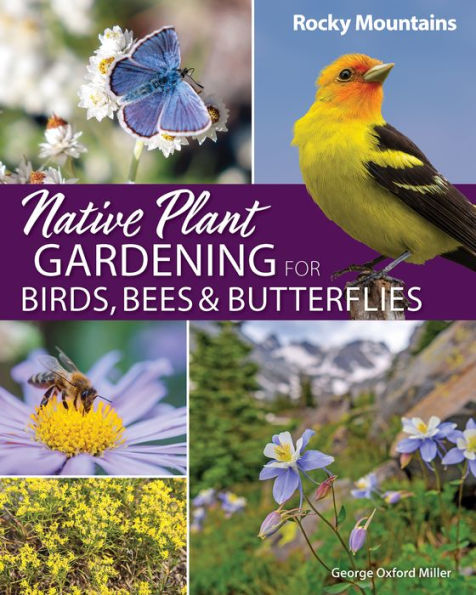Plan your landscape or garden with more than 100 native plants that benefit birds, bees, and butterflies of the Rocky Mountains.
The presence of birds, bees, and butterflies suggests a healthy, earth-friendly place. These most welcome guests also bring joy to those who appreciate watching them. Now, you can turn your yard into a perfect habitat that attracts them and, more importantly, helps them thrive. Professional nature photographer and botanist George Oxford Miller provides the information you need in this must-have guide for Colorado, Idaho, Montana, Wyoming, northern New Mexico, and northeastern Utah. Learn how to landscape and create pollinator gardens with native plants.
The book begins with an in-depth introduction to native pollinators and to birds. It’s followed by a “field guide” section to 106 native plants that are widely available to utilize, are easy to care for, and provide great benefit to birds, bees, and butterflies. Each species includes full-color photographs and information about hardiness zones, what they are most likely to attract, bloom period, growing conditions, and George’s notes. As an added bonus, you’ll make use of the quick-reference chart, garden plans, and more!
Inside you’ll find:
- Overview of native pollinator species in the Rocky Mountain region
- Field guide to 106 native plants, organized by types of plants, such as shrubs, trees, and wildflowers
- Quick-reference chart to plants, blooming periods, and what animals each plant attracts
- Hardiness zone information, weed control tips, and more
- BONUS: Garden plans that can be customized to suit your specific interests
Plan, plant, and grow your beautiful garden, with native plants that benefit your favorite creatures to watch and enjoy.
Plan your landscape or garden with more than 100 native plants that benefit birds, bees, and butterflies of the Rocky Mountains.
The presence of birds, bees, and butterflies suggests a healthy, earth-friendly place. These most welcome guests also bring joy to those who appreciate watching them. Now, you can turn your yard into a perfect habitat that attracts them and, more importantly, helps them thrive. Professional nature photographer and botanist George Oxford Miller provides the information you need in this must-have guide for Colorado, Idaho, Montana, Wyoming, northern New Mexico, and northeastern Utah. Learn how to landscape and create pollinator gardens with native plants.
The book begins with an in-depth introduction to native pollinators and to birds. It’s followed by a “field guide” section to 106 native plants that are widely available to utilize, are easy to care for, and provide great benefit to birds, bees, and butterflies. Each species includes full-color photographs and information about hardiness zones, what they are most likely to attract, bloom period, growing conditions, and George’s notes. As an added bonus, you’ll make use of the quick-reference chart, garden plans, and more!
Inside you’ll find:
- Overview of native pollinator species in the Rocky Mountain region
- Field guide to 106 native plants, organized by types of plants, such as shrubs, trees, and wildflowers
- Quick-reference chart to plants, blooming periods, and what animals each plant attracts
- Hardiness zone information, weed control tips, and more
- BONUS: Garden plans that can be customized to suit your specific interests
Plan, plant, and grow your beautiful garden, with native plants that benefit your favorite creatures to watch and enjoy.

Native Plant Gardening for Birds, Bees & Butterflies: Rocky Mountains

Native Plant Gardening for Birds, Bees & Butterflies: Rocky Mountains
Related collections and offers

Product Details
| ISBN-13: | 9781647554408 |
|---|---|
| Publisher: | Adventure Publications, Incorporated |
| Publication date: | 06/04/2024 |
| Series: | Nature-Friendly Gardens |
| Sold by: | Barnes & Noble |
| Format: | eBook |
| File size: | 45 MB |
| Note: | This product may take a few minutes to download. |
